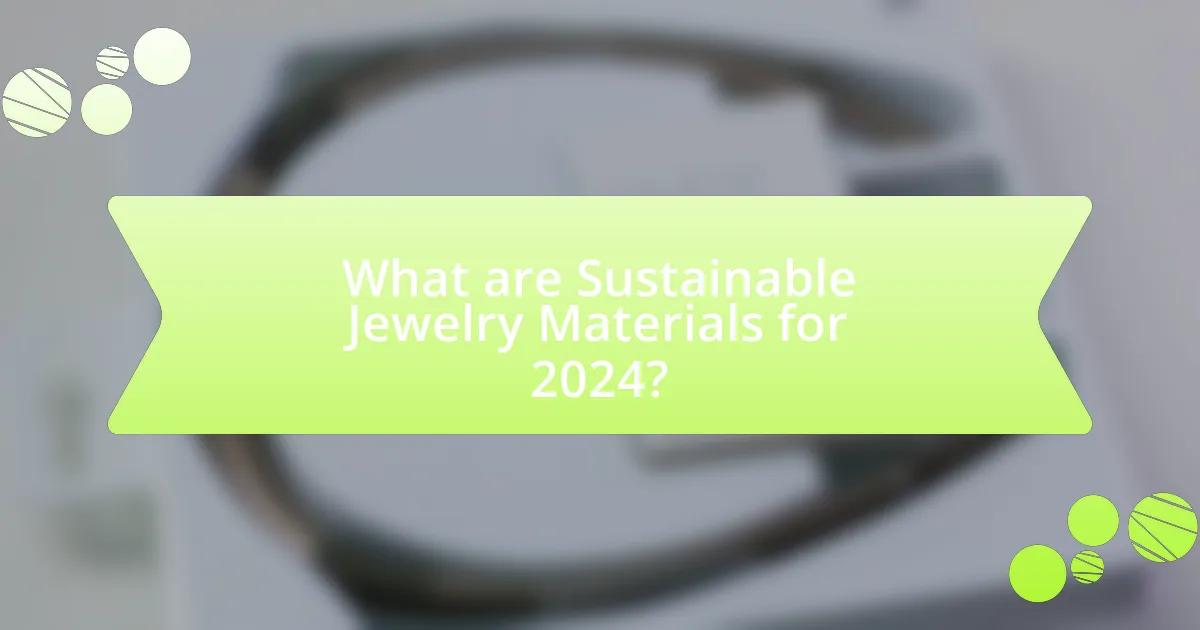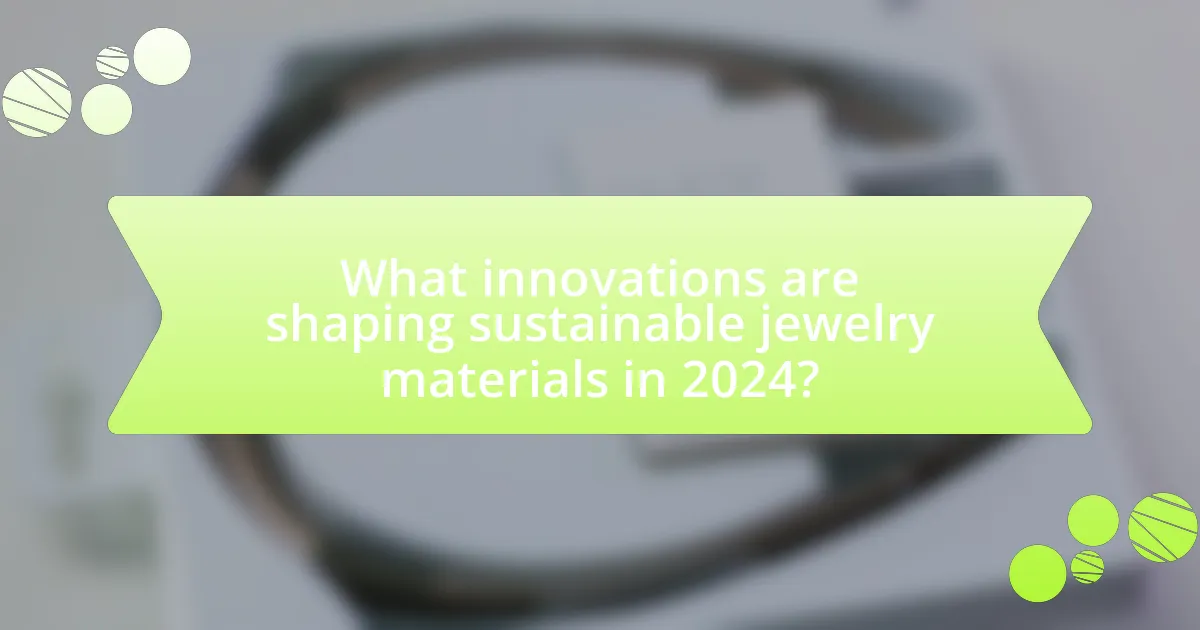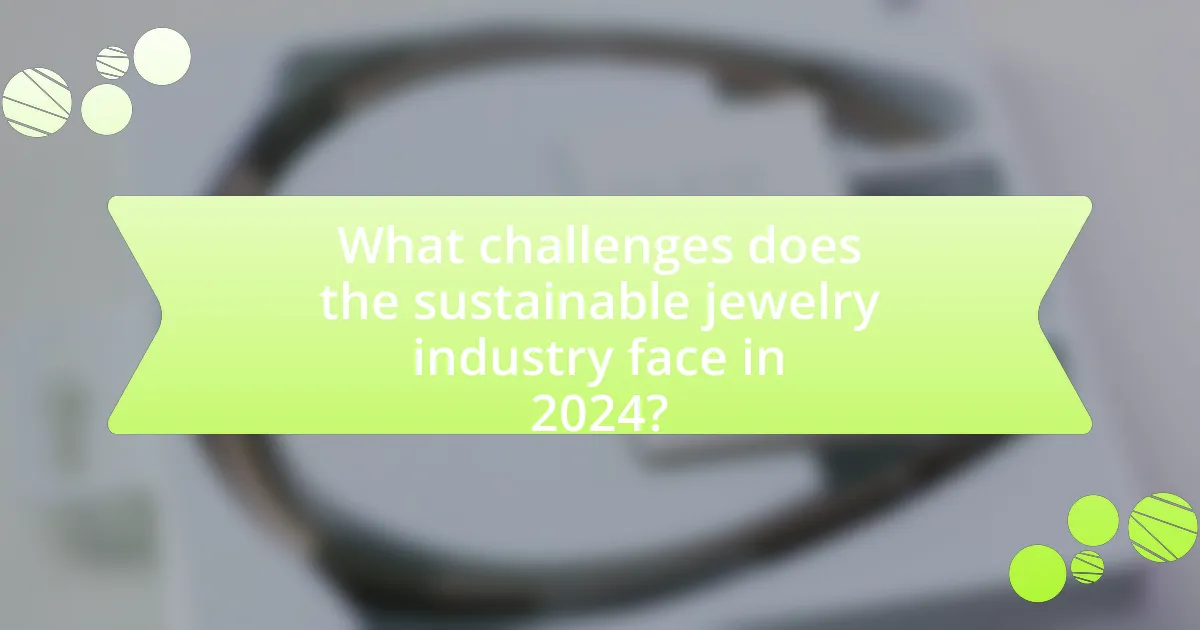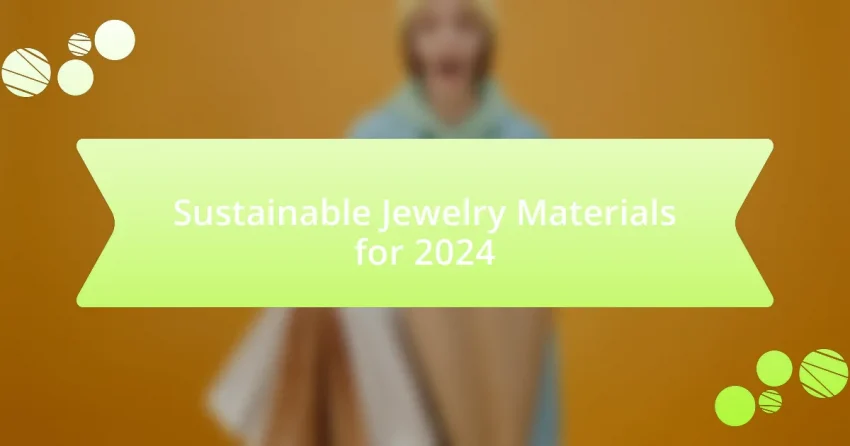The article focuses on sustainable jewelry materials for 2024, highlighting the importance of recycled metals, lab-grown gemstones, and ethically sourced natural materials. It discusses the environmental and ethical implications of traditional jewelry production, emphasizing the need for sustainable practices to reduce ecological footprints and promote fair labor. Key characteristics of sustainable materials, popular options for the year, and innovations in the industry are explored, along with challenges faced in sourcing and consumer perceptions. The article also provides practical tips for consumers to support sustainable jewelry practices and make informed purchasing decisions.

What are Sustainable Jewelry Materials for 2024?
Sustainable jewelry materials for 2024 include recycled metals, lab-grown gemstones, and ethically sourced natural materials. Recycled metals, such as gold and silver, reduce the need for mining and lower environmental impact, as they utilize existing resources. Lab-grown gemstones, like diamonds and sapphires, offer a conflict-free alternative to mined stones, with a significantly lower carbon footprint. Ethically sourced natural materials, including responsibly harvested wood and organic materials, ensure that the extraction process does not harm ecosystems or communities. These materials align with the growing consumer demand for environmentally friendly and socially responsible products in the jewelry industry.
Why is sustainability important in the jewelry industry?
Sustainability is important in the jewelry industry because it addresses environmental and ethical concerns associated with mining and production processes. The extraction of precious metals and gemstones often leads to habitat destruction, pollution, and human rights violations, particularly in developing countries. For instance, the World Gold Council reports that gold mining can produce up to 10 tons of waste for every ounce of gold extracted, highlighting the environmental impact. By prioritizing sustainable practices, the jewelry industry can reduce its ecological footprint, promote fair labor practices, and support responsible sourcing, ultimately fostering a more ethical and environmentally friendly market.
How does the jewelry industry impact the environment?
The jewelry industry significantly impacts the environment through resource extraction, pollution, and waste generation. Mining for precious metals and gemstones often leads to deforestation, habitat destruction, and soil erosion, with studies indicating that gold mining alone can produce up to 20 tons of waste for every ounce of gold extracted. Additionally, the use of toxic chemicals, such as cyanide and mercury, in the extraction process contaminates water sources, harming aquatic ecosystems and posing health risks to local communities. Furthermore, the carbon footprint associated with the production and transportation of jewelry contributes to climate change, with estimates suggesting that the jewelry sector accounts for approximately 5% of global carbon emissions.
What are the ethical implications of traditional jewelry materials?
The ethical implications of traditional jewelry materials primarily revolve around environmental degradation, human rights violations, and unsustainable sourcing practices. Traditional materials such as gold, diamonds, and gemstones often involve mining processes that lead to habitat destruction, soil erosion, and water pollution. For instance, gold mining can produce significant toxic waste, with the World Gold Council reporting that mining operations can generate up to 20 tons of waste for every ounce of gold extracted.
Additionally, the diamond industry has been linked to conflict financing and labor exploitation, particularly in regions where “blood diamonds” are sourced. The Kimberley Process was established to prevent the trade of conflict diamonds, yet its effectiveness has been questioned due to loopholes and lack of enforcement. Furthermore, artisanal mining, while providing livelihoods, often exposes workers to hazardous conditions without adequate safety measures or fair compensation.
These ethical concerns highlight the need for transparency and responsible sourcing in the jewelry industry, prompting a shift towards sustainable alternatives that prioritize environmental stewardship and social responsibility.
What defines sustainable jewelry materials?
Sustainable jewelry materials are defined by their minimal environmental impact, ethical sourcing, and social responsibility throughout their lifecycle. These materials often include recycled metals, ethically mined gemstones, and lab-grown alternatives, which reduce the need for new resource extraction and lower carbon footprints. For instance, recycled gold can save up to 90% of the energy required to produce new gold, while lab-grown diamonds use significantly less water and energy compared to mined diamonds. Additionally, sustainable materials are often certified by organizations that ensure adherence to environmental and ethical standards, such as the Responsible Jewelry Council.
What are the key characteristics of sustainable materials?
Sustainable materials are characterized by their ability to minimize environmental impact, promote social equity, and ensure economic viability. These materials are often sourced from renewable resources, such as bamboo or recycled metals, which reduce the depletion of natural resources. Additionally, sustainable materials are produced using processes that limit carbon emissions and waste, such as low-impact manufacturing techniques. For instance, according to the Ellen MacArthur Foundation, using recycled materials can significantly lower energy consumption and greenhouse gas emissions compared to virgin materials. Furthermore, sustainable materials often adhere to ethical labor practices, ensuring fair wages and safe working conditions for workers involved in their production.
How do sustainable materials differ from conventional ones?
Sustainable materials differ from conventional ones primarily in their environmental impact and sourcing practices. Sustainable materials are derived from renewable resources, designed to minimize waste, and often produced using eco-friendly processes, whereas conventional materials typically rely on non-renewable resources and may involve harmful extraction and manufacturing methods. For instance, sustainable jewelry often utilizes recycled metals and ethically sourced gemstones, reducing the carbon footprint and promoting responsible mining practices, while conventional jewelry may involve mining that disrupts ecosystems and contributes to pollution.
What are the most popular sustainable materials for jewelry in 2024?
The most popular sustainable materials for jewelry in 2024 include lab-grown diamonds, recycled metals, and ethically sourced gemstones. Lab-grown diamonds, which are chemically identical to natural diamonds, have gained traction due to their lower environmental impact and ethical considerations. Recycled metals, such as gold and silver, are favored for their reduced need for mining, thus minimizing ecological disruption. Ethically sourced gemstones, which are obtained from suppliers that adhere to fair labor practices and environmental standards, are increasingly sought after by consumers who prioritize sustainability. These materials reflect a growing trend towards responsible consumption in the jewelry industry.
What are lab-grown diamonds and how are they produced?
Lab-grown diamonds are diamonds that are created in controlled laboratory environments using advanced technological processes that replicate the natural conditions under which diamonds form in the Earth. The two primary methods for producing lab-grown diamonds are High Pressure High Temperature (HPHT) and Chemical Vapor Deposition (CVD).
In the HPHT method, carbon is subjected to extreme pressure and temperature, mimicking the natural geological processes that create diamonds. In the CVD method, a carbon-rich gas is ionized to form a plasma, allowing carbon atoms to deposit onto a substrate and crystallize into diamond. Both methods produce diamonds that are chemically, physically, and optically identical to natural diamonds, as confirmed by gemological studies.
What role do recycled metals play in sustainable jewelry?
Recycled metals are essential in sustainable jewelry as they significantly reduce the environmental impact associated with mining and processing new metals. By utilizing recycled materials, jewelers can decrease energy consumption by up to 90% compared to traditional mining methods, which often involve harmful practices and contribute to habitat destruction. Furthermore, using recycled metals helps to lower carbon emissions, as the recycling process requires less energy and resources. This practice not only conserves natural resources but also promotes a circular economy, where materials are reused and repurposed, thereby minimizing waste.
How are natural gemstones sourced sustainably?
Natural gemstones are sourced sustainably through practices that minimize environmental impact and promote ethical labor conditions. Sustainable sourcing involves methods such as responsible mining, which includes using techniques that reduce land degradation and water pollution, and ensuring that mining operations adhere to strict environmental regulations. For example, some companies engage in artisanal mining, which supports local communities and employs fair labor practices, thereby enhancing social responsibility. Additionally, initiatives like the Kimberley Process Certification Scheme aim to prevent the trade of conflict diamonds, ensuring that gemstones are sourced from conflict-free zones. These practices collectively contribute to a more sustainable gemstone industry, aligning with growing consumer demand for ethically sourced materials.
How can consumers identify sustainable jewelry options?
Consumers can identify sustainable jewelry options by looking for certifications, such as Fair Trade or Responsible Jewelry Council certification, which ensure ethical sourcing and production practices. Additionally, they should seek out brands that disclose their sourcing practices, use recycled materials, or offer transparency about their supply chains. Research indicates that approximately 70% of consumers prefer brands that are transparent about their sustainability efforts, highlighting the importance of informed choices in the jewelry market.
What certifications should consumers look for in sustainable jewelry?
Consumers should look for certifications such as Fair Trade, Responsible Jewelry Council (RJC), and the Kimberley Process when purchasing sustainable jewelry. Fair Trade certification ensures that the materials are sourced ethically, providing fair wages and safe working conditions for miners. The Responsible Jewelry Council certification indicates adherence to ethical, social, and environmental standards throughout the jewelry supply chain. The Kimberley Process aims to prevent the trade of conflict diamonds, ensuring that diamonds are sourced from conflict-free regions. These certifications provide assurance that the jewelry meets specific sustainability and ethical standards.
How can consumers verify the sourcing of materials?
Consumers can verify the sourcing of materials by researching the supply chain transparency of brands and seeking certifications that indicate ethical sourcing practices. Many reputable jewelry brands provide detailed information about their sourcing processes on their websites, including the origin of materials and the conditions under which they are mined or produced. Certifications such as Fair Trade, Responsible Jewelry Council, and Conflict-Free indicate adherence to ethical standards. Additionally, consumers can utilize third-party resources like the Ethical Consumer Guide, which evaluates companies based on their sourcing practices, providing a reliable means to assess the sustainability and ethics of jewelry materials.

What innovations are shaping sustainable jewelry materials in 2024?
Innovations shaping sustainable jewelry materials in 2024 include the use of lab-grown gemstones, recycled metals, and bio-based materials. Lab-grown gemstones, which are chemically identical to natural stones, significantly reduce environmental impact by eliminating mining. Recycled metals, sourced from old jewelry and electronic waste, minimize resource extraction and energy consumption. Additionally, bio-based materials, such as those derived from plant sources or innovative polymers, offer eco-friendly alternatives to traditional materials. These advancements are supported by a growing consumer demand for ethical sourcing and sustainability in the jewelry industry.
How is technology influencing sustainable jewelry production?
Technology is significantly influencing sustainable jewelry production by enabling the use of eco-friendly materials and innovative manufacturing processes. Advanced technologies such as 3D printing allow for precise designs that minimize waste, while blockchain technology enhances transparency in sourcing materials, ensuring they are ethically obtained. For instance, companies like Everledger utilize blockchain to track the provenance of diamonds, confirming their conflict-free status. Additionally, the rise of lab-grown gemstones provides a sustainable alternative to mined stones, reducing environmental impact. According to a report by the World Economic Forum, the adoption of these technologies can lead to a 30% reduction in carbon emissions in the jewelry industry by 2030.
What advancements are being made in lab-grown materials?
Advancements in lab-grown materials include significant improvements in the production of synthetic diamonds and gemstones, which now closely mimic the properties of natural stones. For instance, companies like Diamond Foundry and Brilliant Earth have developed methods to create lab-grown diamonds that are chemically identical to mined diamonds, achieving high clarity and color grades. Additionally, research from the University of California, Berkeley, demonstrates that lab-grown materials can be produced with reduced environmental impact, using less water and energy compared to traditional mining methods. These advancements not only enhance the quality and accessibility of sustainable jewelry but also align with growing consumer demand for ethically sourced materials.
How are 3D printing and sustainable materials being integrated?
3D printing and sustainable materials are being integrated through the development of biodegradable filaments and recycled materials specifically designed for jewelry production. For instance, companies are creating 3D printing filaments from plant-based sources like PLA (polylactic acid) and recycled plastics, which reduce environmental impact while maintaining quality and aesthetics. This integration allows for the production of intricate jewelry designs with minimal waste, as 3D printing utilizes only the material needed for each piece, thereby optimizing resource use. Additionally, research indicates that using sustainable materials in 3D printing can significantly lower carbon footprints, aligning with the growing demand for eco-friendly practices in the jewelry industry.
What trends are emerging in sustainable jewelry design?
Emerging trends in sustainable jewelry design include the use of recycled materials, ethical sourcing of gemstones, and the incorporation of biodegradable elements. Recycled metals, such as gold and silver, are increasingly favored as they reduce the need for mining, which has significant environmental impacts. Ethical sourcing practices ensure that gemstones are obtained from conflict-free zones, promoting social responsibility. Additionally, designers are exploring biodegradable materials, such as plant-based resins, to create pieces that minimize environmental harm. These trends reflect a growing consumer demand for transparency and sustainability in the jewelry industry.
How are designers incorporating eco-friendly practices?
Designers are incorporating eco-friendly practices by utilizing sustainable materials, such as recycled metals and ethically sourced gemstones. For instance, many designers now opt for recycled gold and silver, which significantly reduces the environmental impact associated with mining new metals. Additionally, the use of lab-grown diamonds and gemstones sourced from conflict-free regions ensures that the materials are both ethical and sustainable. According to a report by the Responsible Jewelry Council, the adoption of these practices not only minimizes ecological damage but also promotes social responsibility within the jewelry industry.
What styles are popular among sustainable jewelry collections?
Popular styles among sustainable jewelry collections include minimalist designs, nature-inspired motifs, and upcycled materials. Minimalist designs focus on simplicity and elegance, often using recycled metals and ethically sourced gemstones. Nature-inspired motifs draw from organic shapes and elements, reflecting environmental themes, while upcycled materials incorporate repurposed items, reducing waste and promoting sustainability. These styles resonate with consumers seeking eco-friendly options, as evidenced by a growing market trend towards sustainable fashion, which has seen a 27% increase in demand for ethically produced jewelry in recent years.

What challenges does the sustainable jewelry industry face in 2024?
The sustainable jewelry industry faces significant challenges in 2024, primarily related to sourcing ethical materials, maintaining transparency in supply chains, and competing with traditional jewelry markets. Sourcing ethical materials is complicated by the limited availability of responsibly mined gemstones and recycled metals, which can drive up costs and limit product variety. Transparency in supply chains remains a critical issue, as consumers increasingly demand proof of sustainability, yet many brands struggle to provide verifiable information about their sourcing practices. Additionally, the sustainable jewelry sector competes with traditional jewelry markets that often offer lower prices and wider selections, making it difficult for sustainable brands to attract a broader customer base. These challenges highlight the ongoing need for innovation and commitment to ethical practices within the industry.
What are the barriers to widespread adoption of sustainable materials?
The barriers to widespread adoption of sustainable materials include high costs, limited availability, and lack of consumer awareness. High costs often deter manufacturers from switching to sustainable options, as they may require significant investment in new technologies or sourcing practices. Limited availability of sustainable materials can restrict options for designers and brands, making it challenging to incorporate these materials into their products. Additionally, lack of consumer awareness about the benefits of sustainable materials can lead to lower demand, further hindering their adoption in the market. According to a report by McKinsey & Company, 66% of consumers are willing to pay more for sustainable brands, indicating that increased awareness could drive adoption if barriers are addressed.
How do cost factors affect the availability of sustainable jewelry?
Cost factors significantly limit the availability of sustainable jewelry by increasing production expenses and reducing market accessibility. Sustainable materials, such as ethically sourced gemstones and recycled metals, often come with higher costs due to the rigorous standards for environmental and social responsibility. For instance, a report from the World Gold Council indicates that responsibly sourced gold can be up to 30% more expensive than conventionally mined gold. This price disparity can deter consumers and retailers from prioritizing sustainable options, leading to a narrower selection in the market. Additionally, the higher costs associated with sustainable practices can result in fewer manufacturers willing to invest in sustainable jewelry production, further constraining availability.
What consumer perceptions hinder the growth of sustainable jewelry?
Consumer perceptions that hinder the growth of sustainable jewelry include beliefs that sustainable options are less stylish, more expensive, and of inferior quality compared to traditional jewelry. Many consumers associate sustainable jewelry with a lack of design innovation, leading to the perception that it does not meet their aesthetic preferences. Additionally, the higher price point often associated with sustainable materials creates a barrier, as consumers may prioritize cost over ethical considerations. Research indicates that 66% of consumers are willing to pay more for sustainable brands, yet many still perceive sustainable jewelry as a luxury rather than a viable option. This disconnect between willingness to support sustainability and the perceived value of sustainable jewelry contributes to its slow market growth.
How can the industry overcome these challenges?
The industry can overcome challenges related to sustainable jewelry materials by adopting innovative sourcing practices and enhancing transparency in supply chains. Implementing responsible mining techniques and utilizing recycled materials can significantly reduce environmental impact. For instance, the use of lab-grown gemstones and recycled metals has been shown to lower carbon footprints by up to 90% compared to traditional mining methods. Additionally, establishing certifications for sustainable practices can help consumers make informed choices, thereby driving demand for ethically sourced products.
What role do education and awareness play in promoting sustainable jewelry?
Education and awareness are crucial in promoting sustainable jewelry by informing consumers about the environmental and ethical implications of their purchases. When individuals understand the negative impacts of traditional jewelry production, such as mining practices that harm ecosystems and communities, they are more likely to choose sustainable alternatives. Research indicates that 66% of consumers are willing to pay more for sustainable brands, highlighting the importance of awareness in driving demand for eco-friendly options. Furthermore, educational initiatives can empower artisans and brands to adopt sustainable practices, fostering a market that prioritizes ethical sourcing and production methods.
How can collaborations enhance the sustainable jewelry market?
Collaborations can enhance the sustainable jewelry market by combining resources, expertise, and innovative practices among various stakeholders. For instance, partnerships between jewelry brands and ethical mining companies can ensure a more transparent supply chain, leading to responsibly sourced materials. Additionally, collaborations with environmental organizations can promote awareness and education about sustainable practices, thereby increasing consumer demand for eco-friendly jewelry. A notable example is the partnership between the jewelry brand Brilliant Earth and the non-profit organization, the World Wildlife Fund, which focuses on sustainable sourcing and conservation efforts. Such collaborations not only improve sustainability but also build consumer trust and loyalty, ultimately driving growth in the sustainable jewelry sector.
What practical tips can consumers follow to support sustainable jewelry practices?
Consumers can support sustainable jewelry practices by choosing ethically sourced materials, such as recycled metals and conflict-free gemstones. Ethically sourced materials reduce environmental impact and promote fair labor practices. Additionally, consumers should research brands that prioritize sustainability, as many companies now provide transparency about their sourcing and production processes. Supporting local artisans can also contribute to sustainability, as it often reduces carbon footprints associated with shipping. Lastly, consumers can opt for vintage or second-hand jewelry, which minimizes waste and resource consumption. These actions collectively foster a more sustainable jewelry industry.
How can consumers make informed purchasing decisions?
Consumers can make informed purchasing decisions by researching the sustainability and ethical sourcing of jewelry materials. This involves examining certifications, such as Fair Trade or Responsible Jewelry Council, which indicate adherence to ethical practices. Additionally, consumers should seek transparency from brands regarding their supply chains and the environmental impact of their materials. For instance, a 2021 survey by the Gemological Institute of America found that 70% of consumers are willing to pay more for sustainably sourced jewelry, highlighting the growing demand for ethical practices in the industry.
What are the best practices for caring for sustainable jewelry?
The best practices for caring for sustainable jewelry include regular cleaning, proper storage, and avoiding exposure to harsh chemicals. Regular cleaning with a soft cloth helps maintain the jewelry’s shine and removes dirt or oils that can accumulate. Proper storage in a dry, cool place, preferably in a fabric-lined box or pouch, prevents scratches and tangling. Additionally, avoiding exposure to harsh chemicals found in household cleaners, perfumes, and lotions protects the integrity of sustainable materials, which may be more sensitive than traditional metals and gems. Following these practices ensures the longevity and appearance of sustainable jewelry.
